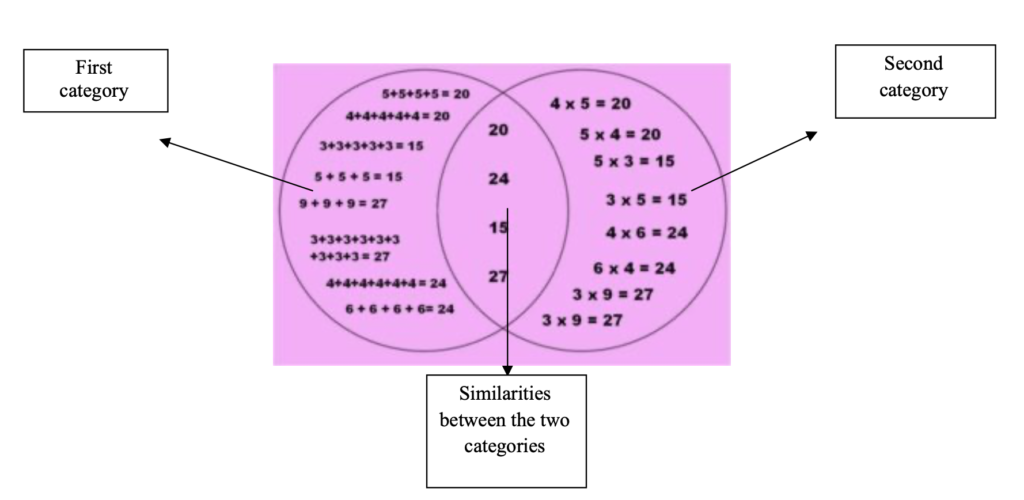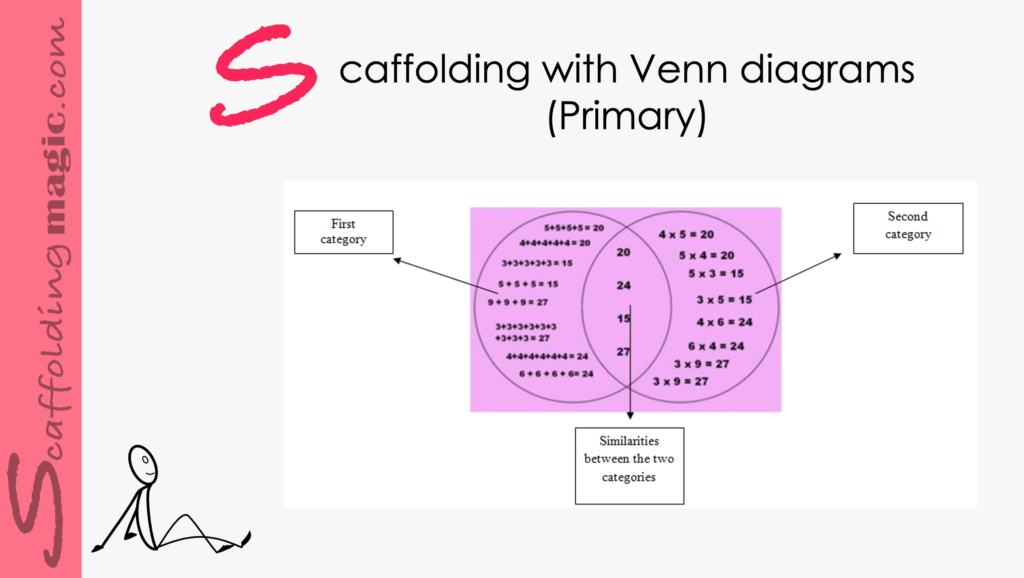You caught a beauty!!!
Download PDF of scaffold here.
Creating and using concept maps tends to have a high positive impact on student achievement.* Concept maps (graphic organisers) help students to see how various pieces of knowledge relate to one another. It helps structure their thinking. ** Venn diagrams are one type of graphic organiser that illustrate similarities, differences, and relationships between concepts, ideas, categories, or groups. This scaffold takes the functionality of Venn Diagrams one step further and uses the dynamic of overlapping circles not only to make categories of information visible, but to actually be the venue through which – by analysing patterns – students can teach themselves new concepts. This is the fundamental goal of scaffolding – to create activities for students that help them pull on past knowledge to move into new knowledge – and to become more independent learners.
Here we use information from a lower Primary maths class – students moving from addition into multiplication. Through interaction and dialogue***, students will discover for themselves the connection between the two mathematical functions. In this way, learning will go deeper and be more meaningful for them in the long term.
step by step
- Divide information from a unit you’re about to begin three ways in the 2-circle overlapping Venn Diagram. (Template here.)

- Make copies for every pair of students.
- Project/show the academic language **** necessary for students to be able to speak about the information effectively, and make sure they understand the meanings. Model one or two equations before they begin the activity.
Example: Bricks: multiply, add, common denominator, etc.
Mortar: plus, equals, right, left, middle, times, same as, etc.
Student 1: In the circle on the left, I see six plus six plus six plus six equals twenty-four.
Student 2: We also see the number 24 in the middle.
Student 1: In the circle on the right, I see six times four equals twenty-four.
Student 2: In the circle on the left, we see four sixes and they equal twenty-four.
Student 1: Yes, that’s right. And on the circle on the right, we see six times four equals the same number.
Student 2: Maybe when we count the numbers in addition and multiply them, it’s the same thing.
Student: Let’s see if that works for the other equations. In the circle on the left we see…
- In pairs, students analyse the Venn Diagram, verbalise what they see, negotiate meaning, and write conclusions.
- Pairs share their conclusions with the rest of the class.
- Formative Assessment:
- a) Give each pair of students addition problems that don’t appear in the Venn Diagram) and have them write the multiplication equation for each.
- b) Give each pair of students blank Venn Diagrams and they fill them in with 8-10 addition problems, the corresponding multiplication problems, and the solutions in the centre.
- Reflection: Students write 75-100 words on the process of figuring out the connection between addition and multiplication. They include how it felt for the teacher to trust them to be able to work out this connection with their partner instead of being taught it directly.
**** We use Jeff Zwiers’ concept of ‘bricks and mortar’ in identifying academic language, here. For more on this concept, you can read his article here.
Other Graphic Organisers to use in different scaffolds:
Education Place
The Cycle: Circular Flow Charts
Scholastic
* (Hattie, 2012)
** (Mehisto, 2017)
*** You’ll see that we’ll need to give our students the academic language necessary to be able to talk about the concepts in the diagrams.


Scaffoldingmagic.com is your entryway into DYNAMIC bilingual learning methodologies, such as Phenomenon-Based Learning, CLIL, EMI, and ESL. You’ll find ways to implement critical thinking tools (DOK) to promote higher level thinking, the growth mindset, instill an ethic of excellence, deep reflection on learning, and all through multi-cultural, interdisciplinary activities. We have the keys to turning competences into action and to creating collective efficacy in your school so you move ahead as a unified, enthusiastic team.



